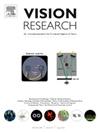斜视和弱视破坏了人类初级视觉皮层的空间知觉,但没有破坏皮层地图的保真度
IF 1.4
4区 心理学
Q4 NEUROSCIENCES
引用次数: 0
摘要
弱视是一种常见的空间视觉障碍,在视觉发育过程中经常与屈光参差、斜视或两者同时存在有关。对于高度可见的刺激,斜视性弱视的受试者经常报告明显的空间扭曲,但这种超阈值缺陷的神经基础尚未得到很好的理解。在这里,我们使用行为测量和高空间分辨率功能性磁共振成像(fMRI)在7 T时的视野测绘相结合的方法来评估12名斜视弱视参与者和9名对照受试者的知觉扭曲。我们通过每只眼睛单眼测量行为和皮层视野图。虽然弱视受试者表现出更多的知觉扭曲,但V1图的布局,通过群体接受野的偏心率和大小来测量,与对照组相比基本没有改变,两组之间的皮层放大没有明显的差异。这表明V1视网膜切除的破坏并不能解释弱视所经历的知觉扭曲。本文章由计算机程序翻译,如有差异,请以英文原文为准。
Strabismus and amblyopia disrupt spatial perception but not the fidelity of cortical maps in human primary visual cortex
Amblyopia is a common disorder of spatial vision and is frequently associated with the presence of anisometropia, strabismus, or both, during visual development. For highly visible stimuli, subjects with strabismic amblyopia often report marked spatial distortions, but the neural basis of this supra-threshold deficit is not well understood. Here, we used a combination of behavioural measurements and visual field mapping with high spatial-resolution functional magnetic resonance imaging (fMRI) at 7 T to assess perceptual distortions in 12 participants with strabismic amblyopia and 9 control subjects. We measured both behavioural and cortical visual field maps monocularly through each eye. Although amblyopic subjects showed increased perceptual distortions, the layout of V1 maps, as measured through the eccentricity and size of population receptive fields, was largely unaltered compared to controls, with no discernible difference in cortical magnification between groups. This suggests that disruptions to V1 retinotopy do not explain the perceptual distortions experienced by amblyopes.
求助全文
通过发布文献求助,成功后即可免费获取论文全文。
去求助
来源期刊

Vision Research
医学-神经科学
CiteScore
3.70
自引率
16.70%
发文量
111
审稿时长
66 days
期刊介绍:
Vision Research is a journal devoted to the functional aspects of human, vertebrate and invertebrate vision and publishes experimental and observational studies, reviews, and theoretical and computational analyses. Vision Research also publishes clinical studies relevant to normal visual function and basic research relevant to visual dysfunction or its clinical investigation. Functional aspects of vision is interpreted broadly, ranging from molecular and cellular function to perception and behavior. Detailed descriptions are encouraged but enough introductory background should be included for non-specialists. Theoretical and computational papers should give a sense of order to the facts or point to new verifiable observations. Papers dealing with questions in the history of vision science should stress the development of ideas in the field.
 求助内容:
求助内容: 应助结果提醒方式:
应助结果提醒方式:


